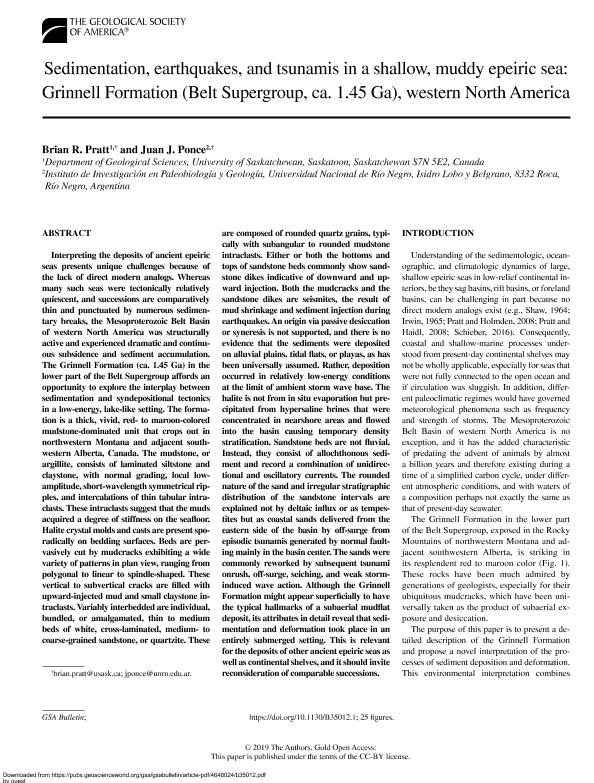Artículo
Sedimentation, earthquakes, and tsunamis in a shallow, muddy epeiric sea: Grinnell Formation (Belt Supergroup, ca. 1.45 Ga), western North America
Fecha de publicación:
11/2019
Editorial:
Geological Society of America
Revista:
Geological Society of America Bulletin
ISSN:
0016-7606
e-ISSN:
1943-2674
Idioma:
Inglés
Tipo de recurso:
Artículo publicado
Clasificación temática:
Resumen
Interpreting the deposits of ancient epeiric seas presents unique challenges because of the lack of direct modern analogs. Whereas many such seas were tectonically relatively quiescent, and successions are comparatively thin and punctuated by numerous sedimentary breaks, the Mesoproterozoic Belt Basin of western North America was structurally active and experienced dramatic and continuous subsidence and sediment accumulation. The Grinnell Formation (ca. 1.45 Ga) in the lower part of the Belt Supergroup affords an opportunity to explore the interplay between sedimentation and syndepositional tectonics in a low-energy, lake-like setting. The formation is a thick, vivid, red- to maroon-colored mudstone-dominated unit that crops out in northwestern Montana and adjacent southwestern Alberta, Canada. The mudstone, or argillite, consists of laminated siltstone and claystone, with normal grading, local lowamplitude, short-wavelength symmetrical ripples, and intercalations of thin tabular intraclasts. These intraclasts suggest that the muds acquired a degree of stiffness on the seafloor. Halite crystal molds and casts are present sporadically on bedding surfaces. Beds are pervasively cut by mudcracks exhibiting a wide variety of patterns in plan view, ranging from polygonal to linear to spindle-shaped. These vertical to subvertical cracks are filled with upward-injected mud and small claystone intraclasts. Variably interbedded are individual, bundled, or amalgamated, thin to medium beds of white, cross-laminated, medium- to coarse-grained sandstone, or quartzite. These are composed of rounded quartz grains, typically with subangular to rounded mudstone intraclasts. Either or both the bottoms and tops of sandstone beds commonly show sandstone dikes indicative of downward and upward injection. Both the mudcracks and the sandstone dikes are seismites, the result of mud shrinkage and sediment injection during earthquakes. An origin via passive desiccation or syneresis is not supported, and there is no evidence that the sediments were deposited on alluvial plains, tidal flats, or playas, as has been universally assumed. Rather, deposition occurred in relatively low-energy conditions at the limit of ambient storm wave base. The halite is not from in situ evaporation but precipitated from hypersaline brines that were concentrated in nearshore areas and flowed into the basin causing temporary density stratification. Sandstone beds are not fluvial. Instead, they consist of allochthonous sediment and record a combination of unidirectional and oscillatory currents. The rounded nature of the sand and irregular stratigraphic distribution of the sandstone intervals are explained not by deltaic influx or as tempestites but as coastal sands delivered from the eastern side of the basin by off-surge from episodic tsunamis generated by normal faulting mainly in the basin center. The sands were commonly reworked by subsequent tsunami onrush, off-surge, seiching, and weak storminduced wave action. Although the Grinnell Formation might appear superficially to have the typical hallmarks of a subaerial mudflat deposit, its attributes in detail reveal that sedimentation and deformation took place in an entirely submerged setting. This is relevant for the deposits of other ancient epeiric seas as well as continental shelves, and it should invite reconsideration of comparable successions.
Archivos asociados
Licencia
Identificadores
Colecciones
Articulos(IIPG)
Articulos de INSTITUTO DE INVESTIGACION EN PALEOBIOLOGIA Y GEOLOGIA
Articulos de INSTITUTO DE INVESTIGACION EN PALEOBIOLOGIA Y GEOLOGIA
Citación
Pratt, Brian; Ponce, Juan Jose; Sedimentation, earthquakes, and tsunamis in a shallow, muddy epeiric sea: Grinnell Formation (Belt Supergroup, ca. 1.45 Ga), western North America; Geological Society of America; Geological Society of America Bulletin; 131; 9-10; 11-2019; 1411-1439
Compartir
Altmétricas




